Hogarth Press bibliographic designs
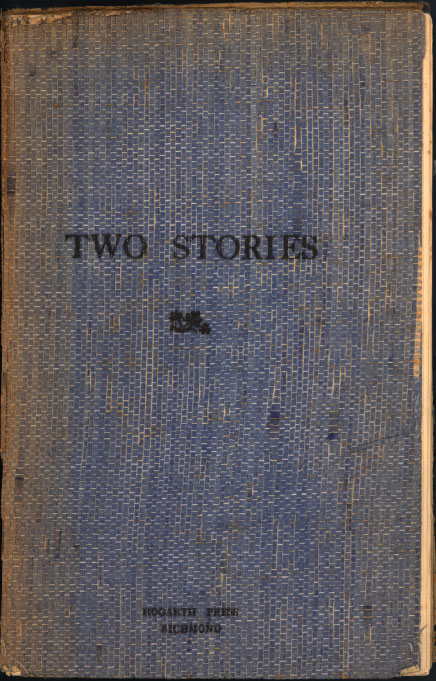
Leonard and Viginia Woolf, Two Stories (1917)
This was the first publication of the Hogarth Press. It contains the story Three Jews by Leonard Woolf and the essay The Mark on the Wall by Virginia Woolf, with four small woodcuts by Dora Carrington. 150 copies were printed. It had 34 pages and sold for 1s. 6d.
We decided to print a paper-covered pamphlet containing a story by each of us and try to sell it by subscription to a limited number of people … We set to work and printed a thirty-two page pamphlet, demy octavo … We bound it ourselves by stitching it into paper covers.
The total number finally sold was 134, and all but five or six of them were friends or acquaintances … The total cost of production was £3 7s. 0d., which included the noble sum of 15s to Carrington for the woodcuts, 12s. 6d. for paper, and 10s. for the cover paper. The two authors were not paid any royalty. The total receipts turned out to be £10 8s. 0d., so that the net profit was £7 1s. 0d.
Leonard Woolf, An Autobiography
Hogarth Press studies
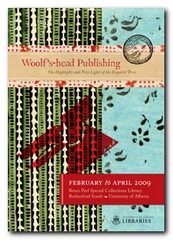 Woolf’s-head Publishing is a wonderful collection of cover designs, book jackets, and illustrations – but also a beautiful example of book production in its own right. It was produced as an exhibition catalogue and has quite rightly gone on to enjoy an independent life of its own. This book is a genuine collector’s item, and only months after its first publication it started to win awards for its design and production values. Anyone with the slightest interest in book production, graphic design, typography, or Bloomsbury will want to own a copy the minute they clap eyes on it.
Woolf’s-head Publishing is a wonderful collection of cover designs, book jackets, and illustrations – but also a beautiful example of book production in its own right. It was produced as an exhibition catalogue and has quite rightly gone on to enjoy an independent life of its own. This book is a genuine collector’s item, and only months after its first publication it started to win awards for its design and production values. Anyone with the slightest interest in book production, graphic design, typography, or Bloomsbury will want to own a copy the minute they clap eyes on it.
![]() Buy the book at Amazon UK
Buy the book at Amazon UK
![]() Buy the book at Amazon US
Buy the book at Amazon US
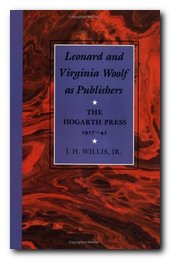 Leonard and Virginia Woolf as Publishers: Hogarth Press, 1917-41 John Willis brings the remarkable story of Leonard and Virginia Woolf’s success as publishers to life. He generates interesting thumbnail sketches of all the Hogarth Press authors, which brings both them and the books they wrote into sharp focus. He also follows the development of many of its best-selling titles, and there’s a full account of the social and cultural development of the press. This is a scholarly work with extensive footnotes, bibliographies, and suggestions for further reading – but most of all it is a very readable study in cultural history.
Leonard and Virginia Woolf as Publishers: Hogarth Press, 1917-41 John Willis brings the remarkable story of Leonard and Virginia Woolf’s success as publishers to life. He generates interesting thumbnail sketches of all the Hogarth Press authors, which brings both them and the books they wrote into sharp focus. He also follows the development of many of its best-selling titles, and there’s a full account of the social and cultural development of the press. This is a scholarly work with extensive footnotes, bibliographies, and suggestions for further reading – but most of all it is a very readable study in cultural history.
![]() Buy the book at Amazon UK
Buy the book at Amazon UK
![]() Buy the book at Amazon US
Buy the book at Amazon US
Bloomsbury Group links
![]() Bloomsbury Group – tutorials, critical studies, resources
Bloomsbury Group – tutorials, critical studies, resources
![]() Bloomsbury Group – portraits and biographies
Bloomsbury Group – portraits and biographies
![]() The Bloomsbury Group – Who Were They?
The Bloomsbury Group – Who Were They?
![]() Hogarth Press book jacket cover designs
Hogarth Press book jacket cover designs
© Roy Johnson 2005
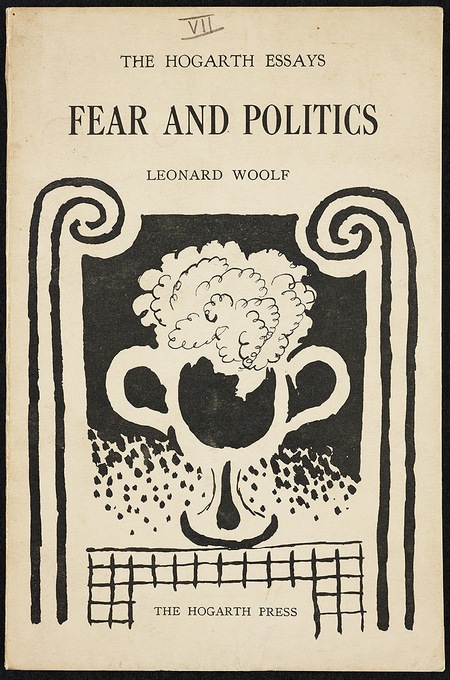
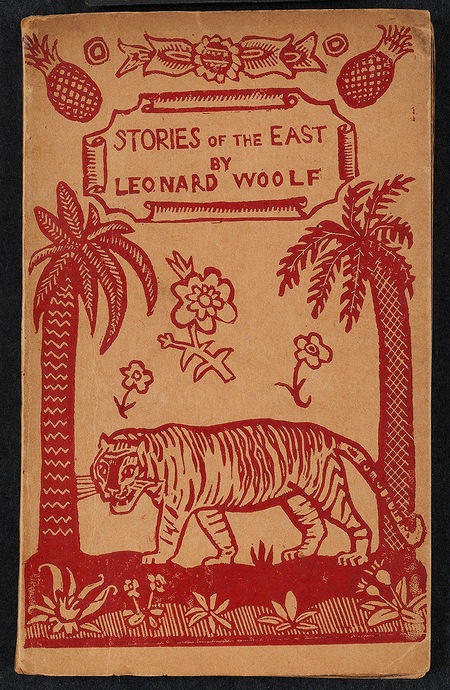
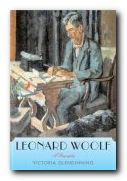
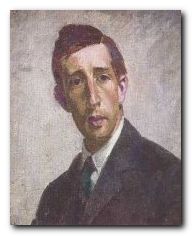 Leonard Sidney Woolf was born in London in 1880, the third of ten children of Solomon Rees Sydney and Marie (de Jongh) Woolf. When his father died in 1892, Woolf was sent to board at the Arlington House School, a preparatory school near Brighton. From 1894 to 1899 he studied on a scholarship as a day student at St. Paul’s, a London public school noted for its classical studies. In 1899 he won a classical scholarship to Trinity College, Cambridge.
Leonard Sidney Woolf was born in London in 1880, the third of ten children of Solomon Rees Sydney and Marie (de Jongh) Woolf. When his father died in 1892, Woolf was sent to board at the Arlington House School, a preparatory school near Brighton. From 1894 to 1899 he studied on a scholarship as a day student at St. Paul’s, a London public school noted for its classical studies. In 1899 he won a classical scholarship to Trinity College, Cambridge.
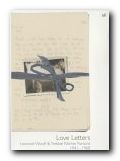
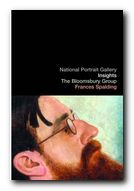 The Bloomsbury Group
The Bloomsbury Group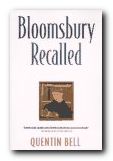 Bloomsbury Recalled
Bloomsbury Recalled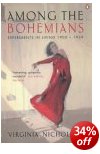 Among the Bohemians: Experiments in Living 1900—1930
Among the Bohemians: Experiments in Living 1900—1930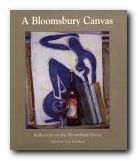 A Bloomsbury Canvas
A Bloomsbury Canvas
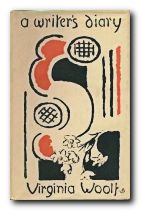 Many of the book jackets were designed by Virginia’s sister, the designer and painter
Many of the book jackets were designed by Virginia’s sister, the designer and painter 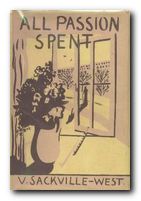 Virginia Woolf is now well known for her love-affair with fellow writer
Virginia Woolf is now well known for her love-affair with fellow writer 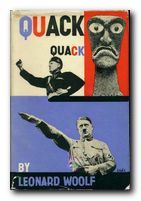 As their enterprise became more successful and the volume of business grew, they felt they needed more help. A succession of younger men were employed to help run the Press – many of them aspirant young writers themselves. Amongst them was Richard Kennedy, a sixteen year old boy, who recorded his very amusing memories of the experience in
As their enterprise became more successful and the volume of business grew, they felt they needed more help. A succession of younger men were employed to help run the Press – many of them aspirant young writers themselves. Amongst them was Richard Kennedy, a sixteen year old boy, who recorded his very amusing memories of the experience in 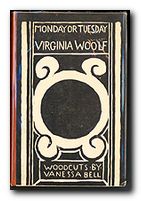 Curiously enough, as John Lehmann records in his account of these years, these disasters proved to be a benefit to the press. Its editorial offices and stock rooms were in the same building as its printers, and both were a long way away from London, where other publishers were suffering losses to their inventory as a result of air raids during the war. The odd thing is that despite paper rationing, sales rose, because of general shortages: “Books that in peacetime, when there was an abundance of choice, would have sold only a few copies every month, were snapped up the moment they arrived in the shops.”
Curiously enough, as John Lehmann records in his account of these years, these disasters proved to be a benefit to the press. Its editorial offices and stock rooms were in the same building as its printers, and both were a long way away from London, where other publishers were suffering losses to their inventory as a result of air raids during the war. The odd thing is that despite paper rationing, sales rose, because of general shortages: “Books that in peacetime, when there was an abundance of choice, would have sold only a few copies every month, were snapped up the moment they arrived in the shops.”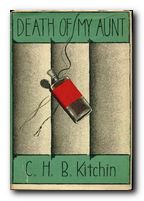 Disagreements rumbled on until after the war had ended. When the final split between them came about in 1946, Leonard solved the financial problem of raising £3,000 to keep the company afloat by persuading fellow publisher Ian Parsons of Chatto and Windus to buy out John Lehmann’s share. The Hogarth Press became a limited company within Chatto & Windus, on the strict understanding that Leonard Woolf had a controlling decision on what the Hogarth Press published.
Disagreements rumbled on until after the war had ended. When the final split between them came about in 1946, Leonard solved the financial problem of raising £3,000 to keep the company afloat by persuading fellow publisher Ian Parsons of Chatto and Windus to buy out John Lehmann’s share. The Hogarth Press became a limited company within Chatto & Windus, on the strict understanding that Leonard Woolf had a controlling decision on what the Hogarth Press published.